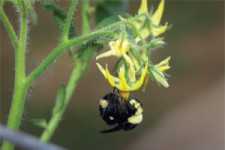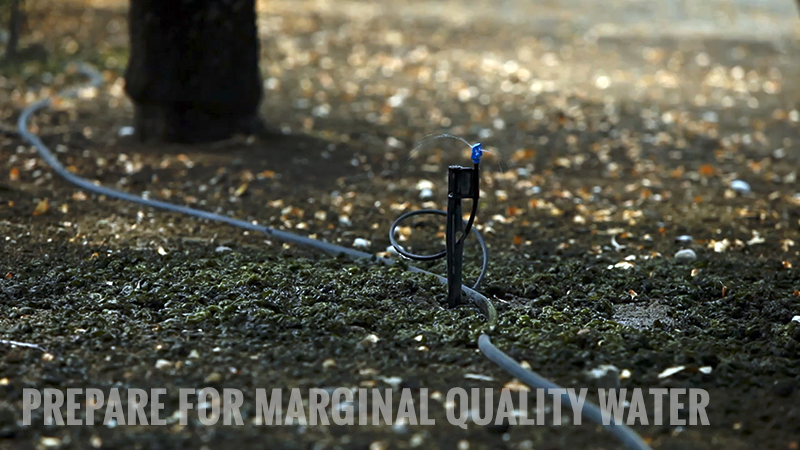Going Native For Bee Supplies

The ongoing crisis over honey bee losses and the cost to rent hives has producers looking for reliable options to pollinate high-value, bee-dependent crops from apples and almonds to watermelon and zucchini. The crisis, commonly referred to as Colony Collapse Disorder (CCD), is prompting more attention for previously overlooked native bees, and researchers are finding some intriguing possibilities.
“Blue orchard bees (Osmia lignaria) have potential in several rosaceous orchard crops like apples, cherries, and plums,” says Theresa Pitts-Singer, a research entomologist with USDA’s Agricultural Research Service. “On a small scale, the blue orchard bee does better than a honey bee. The problem on a grand commercial scale is bee retention. We’re still working out how many blue orchard bees you need per acre because of the retention problem,” she explains.
Both Pitts-Singer and Neal Williams, a University of California (UC)-Davis native pollinator specialist, see a role for native bees in solving the pollination question. “That’s why the blue orchard bee is so interesting,” says Williams, who notes that some smaller scale California farmers already operate successfully without using managed honey bees.
Claire Kremen, UC-Berkeley associate professor of environmental science, has found similar results in studies of watermelon, tomato, and almond production. “We did a lot of work on the surrounding habitat and saw a strong influence (on pollination) from a more diverse habitat around farms,” she says. “Some watermelon producers have found that wild bees can provide all the pollination services they need if there’s enough natural habitat.”
A study released last year concluded that the pollination services of wild, free-living bees contribute $889 million to $2.2 billion annually to California agriculture, where about a third of the industry’s value comes from pollinator-dependent crops.
Better Pollination
Now Kremen’s research is looking at what farmers can do to bring back native pollinators. One option could be to establish a native plant hedgerow — a long, single row of plants that bloom in sequence to provide nectar and pollen over more of the growing season than a single crop can. “We’ve been working with farmers to monitor new plantings, and on farms with long-established hedgerows, we found more native bee species, more individual bees, and more rare species,” Kremen reports. “So we are seeing a positive response. We’re finding bees are more abundant up to several hundred meters away in the farm fields.”
The next question Kremen aims to answer is how a better habitat may translate not just into more bees, but into better pollination services. A second research initiative is looking at the effects of diversifying crops. “Even without a habitat, we’ve observed that some farms with more crop diversity have more diverse native bee communities, so we’re looking at strawberries in Salinas to see if diversification can make up for a lack of natural habitat,” she explains. “The question is: Can you create a ‘bee oasis’ within your farm?”
Meanwhile, Williams is investigating possible synergies between honey bees and native bees. “We don’t know the mechanism, but we’ve found that where there are more native bees present, the value of honey bee visits (to flowers) is increased,” he says. “So if your native bees are more successful, you may need fewer honey bees.”
One major challenge for both scientists and growers is that bee science isn’t a “one-size-fits-all” situation, especially among the more than 4,000 species of native bees, and scientists emphasize the need for more research. Still, as CCD continues to decimate honey bees, USDA has established multiple bee habitat programs, including matching grants and technical assistance available through the Environmental Quality Incentives Program. Encouraging native pollinators is now a ranking criterion that can mean higher payments per acre for new Conservation Reserve Program contracts, and for farmers interested in promoting native bees, more location-specific guidance is becoming available.
For More Information
In addition to USDA’s Natural Resources Conservation Service, growers can find information on several websites, including the Native Pollinators in Agriculture Work Group (www.agpollinators.org), the UC-Davis website (http://entomology.ucdavis.edu/news/nativebeepamphlet.pdf), and the Xerces Society (www.xerces.org/Pollinator), where a click on the map brings up lists of appropriate pollinator-friendly plants by state.
USDA publications are available at www.nrcs.usda.gov/technical/ECS/database/technotes.html, and the Learning Center offers a free book specifically on blue orchard bees at www.sare.org/Learning-Center/Books/How-to-Manage-the-Blue-Orchard-Bee.










